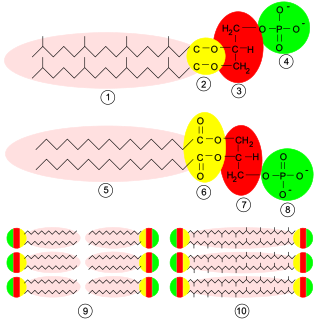Related Research Articles

Lipids are a broad group of naturally-occurring molecules which includes fats, waxes, sterols, fat-soluble vitamins, monoglycerides, diglycerides, phospholipids, and others. The functions of lipids include storing energy, signaling, and acting as structural components of cell membranes. Lipids have applications in the cosmetic and food industries, and in nanotechnology.
Monosaccharides, also called simple sugars, are the simplest forms of sugar and the most basic units (monomers) from which all carbohydrates are built.

Nucleotides are organic molecules composed of a nitrogenous base, a pentose sugar and a phosphate. They serve as monomeric units of the nucleic acid polymers – deoxyribonucleic acid (DNA) and ribonucleic acid (RNA), both of which are essential biomolecules within all life-forms on Earth. Nucleotides are obtained in the diet and are also synthesized from common nutrients by the liver.
Isomerases are a general class of enzymes that convert a molecule from one isomer to another. Isomerases facilitate intramolecular rearrangements in which bonds are broken and formed. The general form of such a reaction is as follows:
A tetrose is a monosaccharide with 4 carbon atoms. They have either an aldehyde functional group in position 1 (aldotetroses) or a ketone functional group in position 2 (ketotetroses).

A ketose is a monosaccharide containing one ketone group per molecule. The simplest ketose is dihydroxyacetone, which has only three carbon atoms. It is the only ketose with no optical activity. All monosaccharide ketoses are reducing sugars, because they can tautomerize into aldoses via an enediol intermediate, and the resulting aldehyde group can be oxidised, for example in the Tollens' test or Benedict's test. Ketoses that are bound into glycosides, for example in the case of the fructose moiety of sucrose, are nonreducing sugars.

Pyridoxal phosphate (PLP, pyridoxal 5'-phosphate, P5P), the active form of vitamin B6, is a coenzyme in a variety of enzymatic reactions. The International Union of Biochemistry and Molecular Biology has catalogued more than 140 PLP-dependent activities, corresponding to ~4% of all classified activities. The versatility of PLP arises from its ability to covalently bind the substrate, and then to act as an electrophilic catalyst, thereby stabilizing different types of carbanionic reaction intermediates.
Biosynthesis is a multi-step, enzyme-catalyzed process where substrates are converted into more complex products in living organisms. In biosynthesis, simple compounds are modified, converted into other compounds, or joined to form macromolecules. This process often consists of metabolic pathways. Some of these biosynthetic pathways are located within a single cellular organelle, while others involve enzymes that are located within multiple cellular organelles. Examples of these biosynthetic pathways include the production of lipid membrane components and nucleotides. Biosynthesis is usually synonymous with anabolism.

Sedoheptulose or pseudoheptulose or D-altro-heptulose is a ketoheptose—a monosaccharide with seven carbon atoms and a ketone functional group. It is one of the few heptoses found in nature, and is found in various fruits and vegetables ranging from carrots and leeks to figs, mangos and avocados.

Glycerophospholipids or phosphoglycerides are glycerol-based phospholipids. They are the main component of biological membranes. Two major classes are known: those for bacteria and eukaryotes and a separate family for archaea.

Transketolase is an enzyme that is encoded by the TKT gene. It participates in both the pentose phosphate pathway in all organisms and the Calvin cycle of photosynthesis. Transketolase catalyzes two important reactions, which operate in opposite directions in these two pathways. In the first reaction of the non-oxidative pentose phosphate pathway, the cofactor thiamine diphosphate accepts a 2-carbon fragment from a 5-carbon ketose (D-xylulose-5-P), then transfers this fragment to a 5-carbon aldose (D-ribose-5-P) to form a 7-carbon ketose (sedoheptulose-7-P). The abstraction of two carbons from D-xylulose-5-P yields the 3-carbon aldose glyceraldehyde-3-P. In the Calvin cycle, transketolase catalyzes the reverse reaction, the conversion of sedoheptulose-7-P and glyceraldehyde-3-P to pentoses, the aldose D-ribose-5-P and the ketose D-xylulose-5-P.

Novobiocin, also known as albamycin or cathomycin, is an aminocoumarin antibiotic that is produced by the actinomycete Streptomyces niveus, which has recently been identified as a subjective synonym for S. spheroides a member of the class Actinomycetia. Other aminocoumarin antibiotics include clorobiocin and coumermycin A1. Novobiocin was first reported in the mid-1950s.

Transaldolase is an enzyme of the non-oxidative phase of the pentose phosphate pathway. In humans, transaldolase is encoded by the TALDO1 gene.

Diphosphomevalonate decarboxylase (EC 4.1.1.33), most commonly referred to in scientific literature as mevalonate diphosphate decarboxylase, is an enzyme that catalyzes the chemical reaction
The aminocyclitols are compounds related to cyclitols. They possess features of relative and absolute configuration that are characteristic of their class and have been extensively studied; but these features are not clearly displayed by general methods of stereochemical nomenclature, so that special methods of specifying their configuration are justified and have long been used. In other than stereochemical respects, their nomenclature should follow the general rules of organic chemistry.
Core oligosaccharide is a short chain of sugar residues within Gram-negative lipopolysaccharide (LPS). Core-OS are highly diverse among bacterial species and even within strains of species

Mannoheptulose is a heptose, a monosaccharide with seven carbon atoms, and a ketose, with the characteristic carbonyl group of the carbohydrate present on a secondary carbon. The sugar alcohol form of mannoheptulose is known as perseitol.
D-glycero-beta-D-manno-heptose-7-phosphate kinase is an enzyme with systematic name ATP:D-glycero-beta-D-manno-heptose 7-phosphate 1-phosphotransferase. This enzyme catalyses the following chemical reaction
D-glycero-beta-D-manno-heptose 1-phosphate adenylyltransferase is an enzyme with systematic name ATP:D-glycero-beta-D-manno-heptose 1-phosphate adenylyltransferase. This enzyme catalyses the following chemical reaction
D-sedoheptulose 7-phosphate isomerase is an enzyme with systematic name D-glycero-D-manno-heptose 7-phosphate aldose-ketose-isomerase. This enzyme catalyses the following chemical reaction
References
- ↑ Horecker, B. L; Smyrniotis, P. Z (1953). "Transaldolase: The Formation of Fructose-6-Phosphate from Sedoheptulose-7-Phosphate". Journal of the American Chemical Society. 75 (8): 2021. doi:10.1021/ja01104a532.
- ↑ Patra, Krushna C; Hay, Nissim (2014). "The pentose phosphate pathway and cancer". Trends in Biochemical Sciences. 39 (8): 347. doi:10.1016/j.tibs.2014.06.005. PMC 4329227 . PMID 25037503.
- ↑ Liu, Xuan; Sievert, James; Arpaia, Mary Lu; Madore, Monica A. (2002-01-01). "Postulated Physiological Roles of the Seven-carbon Sugars, Mannoheptulose, and Perseitol in Avocado". Journal of the American Society for Horticultural Science. 127 (1): 108–114. doi: 10.21273/JASHS.127.1.108 . Retrieved 2018-06-26.
- ↑ Patricia L. Taylor, Kim M. Blakely, Gladys P. de Leon, John R. Walker, Fiona McArthur, Elena Evdokimova, Kun Zhang, Miguel A. Valvano, Gerard D. Wright, Murray S. Junop (1 February 2008). "Structure and Function of Sedoheptulose-7-phosphate Isomerase, a Critical Enzyme for Lipopolysaccharide Biosynthesis and a Target for Antibiotic Adjuvants". Journal of Biological Chemistry. 283 (5): 2835–2845. doi: 10.1074/jbc.M706163200 . PMID 18056714.
{{cite journal}}: CS1 maint: multiple names: authors list (link)